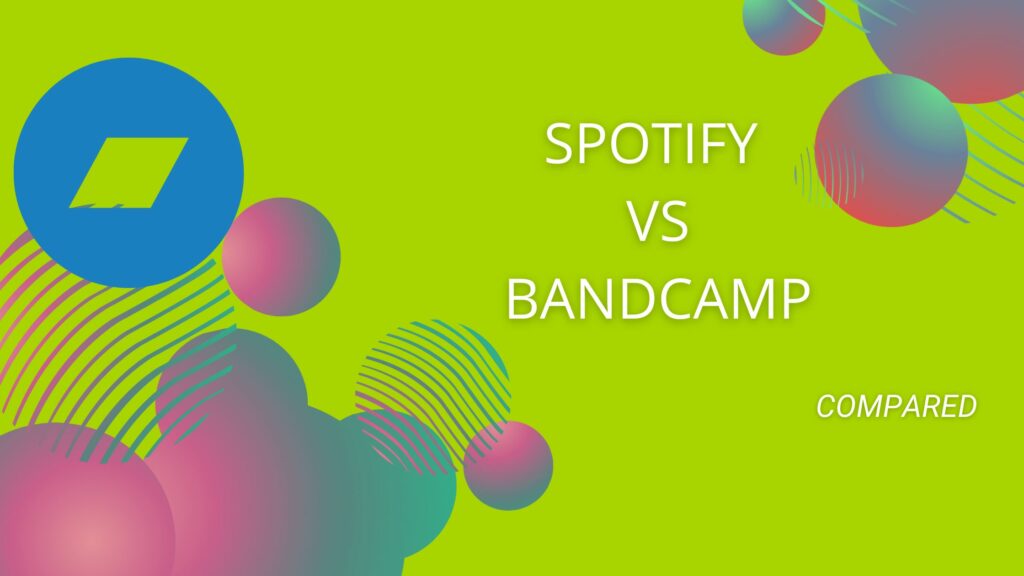Bandcamp and Spotify are both popular online music platforms, but they have different focuses and target audiences. While Spotify is a streaming service, Bandcamp is an online music platform that allows independent musicians to sell their music directly to their fans. But why Bandcamp is better than Spotify? In this article, we will compare and contrast Bandcamp and Spotify to help you understand why Bandcamp is a better option for independent musicians.

Spotify vs Bandcamp- Quick Comparison
| Feature | Spotify | Bandcamp |
|---|---|---|
| Music library size | Over 70 million songs | Varies by artist |
| Streaming quality | Up to 320 kbps | Varies by artist |
| Free version | Limited features with ads | Limited Free version, downloads allowed |
| Paid version | Premium subscription for ad-free and offline listening | Digital purchases and subscriptions available. |
| Revenue model | Subscription-based and advertising | Direct sales and fan subscriptions |
| Discovery features | Personalized playlists and recommendations | Artist-created tags and fan-made collections |
| Social features | Follow and share playlists, see what friends are listening to | Commenting, sharing and direct messaging with artists |
1. Direct-to-Consumer (DTC) Model
One of the main reasons why Bandcamp is better than Spotify is its direct-to-consumer sales model. This model allows independent musicians to sell their music directly to their fans without the need for a record label or distribution deal. This empowers musicians to take control of their careers and build a fanbase on their own terms.
Additionally, Bandcamp offers a wider range of monetization options, including the ability to sell digital downloads, physical copies, and merchandise, as well as the ability to offer discounts and pre-orders. This diversity in revenue stream helps independent musicians to increase their revenue.
2. Strong Fan Management
Another key advantage of Bandcamp is its strong community and fan engagement. The platform has a community of music lovers that supports and promotes independent musicians, which helps them to gain more exposure and increase their revenue.
Additionally, the platform offers a fan-to-artist direct messaging system, which allows fans to connect with their favorite musicians, ask questions, and share feedback on their music. This creates a sense of personal connection and engagement that is unique to Bandcamp.
3. Justifiable Revenue Sharing Model
Bandcamp also operates with transparency and ethical business practices. They have a clear and fair revenue-sharing model, which ensures that musicians receive a fair share of the revenue generated by their music.
Further, the platform has a strict anti-piracy policy, which helps to protect the rights of independent musicians. Spotify, on the other hand, operates on a revenue-sharing model, where the company takes a percentage of the revenue generated by the content uploaded on the platform.
4. Pricing
When it comes to pricing, Bandcamp operates on a direct-to-consumer model and charges a 15% fee on digital sales, 10% fee on merchandise sales and a 3-5% payment processing fee. Spotify, on the other hand, offers a free version with limited features, as well as a Premium subscription which costs $9.99 per month.
The premium subscribers are allowed to download Bandcamp albums & songs more than the free ones.
5. Engagement
In terms of community and fan engagement, Bandcamp has a more active community of music lovers that supports and promotes independent musicians, which helps them to gain more exposure and increase their revenue.
Also, the platform offers a fan-to-artist direct messaging system, which allows fans to reach out to their favorite musicians, ask questions, and share feedback on their music. This creates a sense of personal connection and engagement that is unique to Bandcamp. Spotify, on the other hand, has a more general audience and less of a focus on community and fan engagement.
Another advantage of Bandcamp is the flexibility it offers in pricing and product offerings. Independent musicians can experiment with different pricing strategies and product offerings to see what works best for them. This allows them to cater to a wider range of audiences and increase their revenue. Spotify, on the other hand, operates on a fixed pricing model with limited options for independent musicians to monetize their music.
When it comes to compatibility, Bandcamp is compatible with desktop and mobile devices, while Spotify is compatible with a wide range of devices and platforms, including desktop, mobile, smart speakers, and gaming consoles.
Does Spotify Have Better Sound Quality?
Spotify’s sound quality varies depending on the subscription plan you have. The free version of Spotify has a lower bitrate, which results in lower sound quality. The paid subscription plans, Spotify Premium and Spotify Hi-Fi, offer higher bitrate streaming and therefore better sound quality. Spotify Hi-Fi offers lossless CD-quality streaming, which is the highest sound quality available on Spotify.
In addition to the differences in sound quality between the free and paid subscription plans, Spotify also offers the ability to customize the streaming quality to suit your individual needs. With the Premium and Hi-Fi plans, you can adjust the streaming quality to match your internet connection, and even download songs for offline listening at the highest quality possible.
Conclusion | Spotify & Bandcamp
In conclusion, Bandcamp offers independent musicians a better option for selling and promoting their music. Its direct-to-consumer sales model, wide range of monetization options, strong community and fan engagement, transparency and ethical business practices, flexibility in pricing and product offerings, and compatibility with desktop and mobile devices make it a more suitable platform for independent musicians. While Spotify is a great platform for music discovery and streaming, it is not as well-suited for independent musicians looking to monetize their music and build a fanbase.

Hi, I’m Lara, a music enthusiast who has a passion for discovering and supporting independent artists on Bandcamp. Lara has been a frequent user of the platform for several years and has built a large collection of Bandcamp albums, songs, and artists that she loves. Lara’s love for music started at a young age when his parents introduced him to a wide range of genres. She has been a devoted fan of indie and alternative music, and she discovered Bandcamp as a teenager.